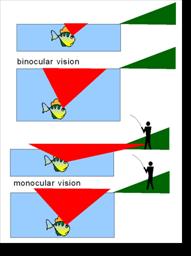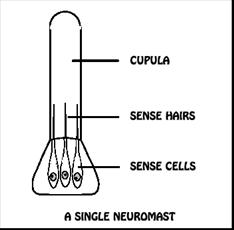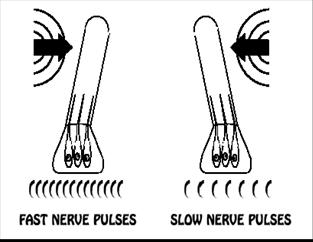WHAT BASS AND BLUEGILL SEE (PART 2)
Webmaster Note:
PART 1 What bass see is found here.
Skunked again. Boudreaux had to go back to the cottage again to face Clotille with an empty ice chest. For two days he and Thibodeaux had cast every fly in their boxes to every spot where they sort of remembered stumps were before the waters covered them all up. When the water was down, Thibodeaux had made a map on the back of a poorboy wrapper with an dot for each stump. Of course, Thibodeaux forgot to put in landmarks or compass points, so it mostly looked like a round faced kid with freckles. When the water came up it turned murky and brown, hiding everything below the surface. They did have some excitement when Boudreaux hooked into a choupique – which would have been fine because Clotille makes a great choupique courtbouillion – but that fish dragged the boat around for ten minutes before stripping the drag on Boudreaux’s reel and mauling his wooly bugger.
“Whatcha gonna tell her this time?” Thibodeaux asked.
Boudreaux answered confidently. “I found the perfect excuse.”
“What?”
“Well, you know how this month’s been cold then its been hot?”
“Lots of cold, yea,” Thibodeaux answered, remembering chilly nights.
“And how we got big storms one day then clear skies the next.”
“Yea.”
“And when we got all that snow?”
“Yea. “A half inch was a blizzard on the bayou.
“And how we had all that rain”
“Yea.”
“And then it didn’t for weeks.”
“Yea.”
“And remember how we got Kartina and Rita and Gustav then nothing for two years?”
“Yea, thank goodness.”
“Well that’s it.”
“That’s what? You gonna blame bad fishing on Katrina?”
“No, already used that. But, think about it. Snow then hot, rain then dry, storms then none. Well hell, if it can cause all that, it can damn sure make the fishing go bad.”
“No, Boudreaux. You’re not going to tell Clotille that ....?”
“You bet. We didn’t catch fish because of... global warming.”
Boudreaux’s skunking was likely not a result of global warming as much as it was his choice of flies. While a wooly bugger is widely acknowledged to be a bass getter, the better choice for stained and murky water is a water moving noisy fly. Why? Because when conditions permit, bass are sight feeders and rely heavily on seeing their prey. When clarity is low, they rely on their lateral line system instead of sight.
 Huh? True story. Bass do not have headlights, or night vision goggles, or infrared visors. What they have is sort of like sonar.
Huh? True story. Bass do not have headlights, or night vision goggles, or infrared visors. What they have is sort of like sonar.
To crawl or not to crawl, that is the question. Some fishermen acquaint stealthy fishing with crawling to a location. There is a certain logic involved in crawling. Sound and vibration travel four to five times faster in water then they do in air. Bass detect distant sounds with their inner ear. They identify closer sounds through their lateral line which runs around their head and from behind their gill plate to their tail. At distances of more than twenty feet, a bass will hear sounds with its inner ear. These sounds are transmitted through the skin, muscle and bone to the ear, but the bass will generally not be able to detect the source or its location. To pinpoint objects, bass utilize their lateral line. What is it? The lateral line is a displacement-pressure receptor that "feels" the pressure waves (basically vibrations) created by objects moving through or near the water. At distances of thirty feet or less (although it also works to a lesser extent at greater distances), bass employ their lateral line to detect underwater pressure changes/vibrations and noise sources. Why should you care? Because the sound/distance factor is significant if you are in an area with little cover and are wading, tube fishing, fishing from a boat, or just walking along the bank. What this means is that when casting in waters with sparse cover, you want to position yourself at least thirty feet away from your target. Not that you can assume thirty feet is enough. And that is because?
Bass can see colors but have binocular vision for only a small angle between their eyes. This angle limits their ability to see a wide area out of the water. However, when looking out of one eye, their monocular vision can see a much larger angle. A shallow fish sees object further across the water’s surface because of this monocular angle (see diagram). Consequently, thirty feet may be too close if fish are in skinny water. Which simply means it is true that fish see a standing fisherman better than a crawling fisherman and, as a bonus, crawling may create less vibrations than walking. But another even simpler solution may be to walk lightly and wear clothing to match the background. Sky blue or forest green shirts have a camouflage factor going for them, while in other areas actual camouflage may be the answer. Walking gently to a fishing location wearing background matching colors and standing still for a while will usually work to have the bass return to its home location. Avoid clothing colors like white (stork-ish) or dark blues (heron-ish) or bright fluorescents (too alien).
But back to the lateral line. The underwater world is not as silent as some might think. Bass are very aware of the sounds that are normal parts of their environment. What many folks fail to realize is that a bass has probably lived its entire life within one hundred yards of the same location (often much less). The bass knows what “home” is supposed to sound like and feel like. For instance, bass that live in lakes on golf courses can become accustomed to balls landing in the water and often don’t react to a splash. Working a popping bug under those circumstances may take very aggressive stripping to convince the bass that your popper is not a ball.
Humans tend to relax in familiar comfortable surroundings. Vision, smell, and hearing are all senses that are familiar to humans because of our own experience with them. These help us identify a familiar setting. Bass accomplish the same with sight, smell and their lateral line. The lateral line system responds to any type of water movement, vibrations, disturbances, currents and even the action of other fishes. It is the principal component defining what’s happening in a bass’ favorite place.
The sensory receptors of the lateral line are called neuromasts, which are similar to organs found in a human’s inner ear. A neuromast consists of a number of hair cells enclosed in a cupula similar to the cells that give us equilibrium. For bass, the most important neuromasts are embedded in the floor of mucus-filled structures called lateral line canals. These canals are just underneath the skin, and the receptor portion of each neuromast extends into the canal and connects to the nervous system.
 Because it is critical to survival, a bass can differentiate between vibrations it feels. The lateral line doesn’t care about light or the color or murkiness of the water environment. If there are many suspended solids in the water, the sensitivity may be slightly lessened, but a bass in murky water is likely used to being in murky water and has adapted to sensing very subtle changes. A bass’ usual neighbors don’t make big splashy noises like wading and paddling does. In comparison to the vibrations caused by stork or heron feet, a human step on the shore is probably quite “loud,” but both “noises” spell danger. When a bass detects an unfamiliar vibration, it knows something different is occurring in the environment around it. At that point, the bass must decide if the change is caused by predator or prey. Scientists believe that a fish can filter out familiar “noises” to focus on unfamiliar ones. That’s when the fish takes action to feed or to protect itself. It’s similar to how people filter out conversations in a noisy room to focus on only one voice. Successful husbands get very good at doing this. The best example is a child athlete. The one voice a child hears at a ball game is his parent’s voice. Coaches hate that because parents usually yell bad advice. Bass can focus the same way, because their game is survival.
Because it is critical to survival, a bass can differentiate between vibrations it feels. The lateral line doesn’t care about light or the color or murkiness of the water environment. If there are many suspended solids in the water, the sensitivity may be slightly lessened, but a bass in murky water is likely used to being in murky water and has adapted to sensing very subtle changes. A bass’ usual neighbors don’t make big splashy noises like wading and paddling does. In comparison to the vibrations caused by stork or heron feet, a human step on the shore is probably quite “loud,” but both “noises” spell danger. When a bass detects an unfamiliar vibration, it knows something different is occurring in the environment around it. At that point, the bass must decide if the change is caused by predator or prey. Scientists believe that a fish can filter out familiar “noises” to focus on unfamiliar ones. That’s when the fish takes action to feed or to protect itself. It’s similar to how people filter out conversations in a noisy room to focus on only one voice. Successful husbands get very good at doing this. The best example is a child athlete. The one voice a child hears at a ball game is his parent’s voice. Coaches hate that because parents usually yell bad advice. Bass can focus the same way, because their game is survival.
 Covering the sense hairs in the neuromast is a jelly-like cupula. The cupula is the part that extends from the lateral line canal, and which is affected by the watery environment. About now you might be asking yourself why scales don’t affect the neuromasts. As it turns out, scales along the lateral line have tiny pores that allow water to enter this canal system. When underwater vibrations occur, they cause water movement in the lateral line canal and against the cupula, causing it to bend. This causes the sense hairs enclosed by the cupula to bend as well, stimulating the nervous system to transmit this information to the bass’ brain. Apparently, when the cupula is bent in one direction, the frequency of these transmitted neural pulses to the brain is increased, and when it is bent the opposite direction, the frequency is decreased. Thus, the fish is able to discern the direction of the source of the vibrations by the frequency of the nerve pulses. Consider that between the bass and a source of the vibrations twenty feet away there are about sixty-one hundred millimeters. A bass is able, by a lifetime of experience with the fast/slow pulses, to know were along that sixty-one hundred spaces the object is and which direction and how fast it is moving. [No one is exactly sure how minute the sensitivity range of a bass might be, but you get the idea... the lateral line system is highly sensitive.] Blind bass or bass engaged in experiments involving limited vision have shown that bass can locate prey without sight. How else would a bass be able to find a fly or lure at night in murky water?
Covering the sense hairs in the neuromast is a jelly-like cupula. The cupula is the part that extends from the lateral line canal, and which is affected by the watery environment. About now you might be asking yourself why scales don’t affect the neuromasts. As it turns out, scales along the lateral line have tiny pores that allow water to enter this canal system. When underwater vibrations occur, they cause water movement in the lateral line canal and against the cupula, causing it to bend. This causes the sense hairs enclosed by the cupula to bend as well, stimulating the nervous system to transmit this information to the bass’ brain. Apparently, when the cupula is bent in one direction, the frequency of these transmitted neural pulses to the brain is increased, and when it is bent the opposite direction, the frequency is decreased. Thus, the fish is able to discern the direction of the source of the vibrations by the frequency of the nerve pulses. Consider that between the bass and a source of the vibrations twenty feet away there are about sixty-one hundred millimeters. A bass is able, by a lifetime of experience with the fast/slow pulses, to know were along that sixty-one hundred spaces the object is and which direction and how fast it is moving. [No one is exactly sure how minute the sensitivity range of a bass might be, but you get the idea... the lateral line system is highly sensitive.] Blind bass or bass engaged in experiments involving limited vision have shown that bass can locate prey without sight. How else would a bass be able to find a fly or lure at night in murky water?
Bass in a pond are frequently confronted with glumps of this or that. Pieces of vegetation are green or brown and unless there are insects of those colors, bass will see a brown/green fly as a plant. Remember, bass don’t eat vegetation. But, if an olive nymph is a native species, which may be the only successful color. Confusing? Of course it is.
Here are some recommendations. (1) Surface flies: (a) Popping bugs should be very noisy and have contrasting colors. Noisy in this instance means a lot of water disturbance more than just audible sound. Believe it or not, a long gurgler with an undulating tail may disturb water for longer than a shallow faced popper. Frogs should have flexible long legs to accomplish the same thing. (b) Retrieve the fly with rod tip down and strong strips – again to move a lot of water (c) Unless the fly is imitating a single colored prey it should have contrasting colors in the general color palate of the prey. Adding a dark spot or line (red or black) helps to create the necessary contrast. (2) Wet flies: (a) A wooly bugger is successful because it has a lot of wiggly parts to get noticed by the bass’ lateral line. Large palmered hackle is a good thing as is a long tail of marabou, hackle or rabbit. Using a bead or cone head will cause the fly to move through the water on retrieve in a sine wave, which signals the lateral line. The rod can be fished at a 45 degree angle or so to accentuate this wave. (b) A clouser represents baitfish and should be appropriately colored with a strong contrast between the body of the fly and the dorsal area. Red highlights near the eyes will contrast as a flared gill would. (3) Bottom bumpers. Crawfish imitations and similar flies (e.g. the Calcasieu Pigboat) are bumped along the bottom. Colors for these can be much darker as bottom dwellers tend to have darker camouflage. Bass will both see a dark shape and feel the motion and action against the bottom. Few crawfish patterns include a rattle.but they should. (4) Insects: (a) Floating terrestrials can be any of thousands of colors because that is how nature made hoppers and beetles. Bass infrequently take ant patterns (too much effort for the reward) but will slurp down a dragonfly if it comes close. Hopper and beetle legs are very active in the water and should be so on a fly. Knotted legs are pretty but not mandatory. Long dangley legs should not be so long they get hung up in the turn of the hook. Remember, the bass is going to see the underside of the fly so contrast for the purpose of make the fly more visible to the bass should be on the underside. A good trick is to use black tread on a foam hopper/beetle body so that a black line separates each segment. Similarly, black legs on a light colored fly and light colored legs on a dark fly accomplish the same. (b) Selecting wet insect flies poses a conundrum. For the most part, size is irrelevant. Large bass are taken on tiny flies. Wiggley parts are helpful, but if they are absent a retrieve which imparts a lot of movement to the fly can be successful. Color is a matter of experimentation. This is one instance in which contrast may not be required if abundant species of monochrome insects are present. Bright colors in off-colored water will frequently produce when darker colors will not. All of which means that experimentation is the best course of action.
Mayeaux left work early Friday afternoon. Instead of going home, he squandered the weekend (and his paycheck) partying with the boys in Anjolee’s Pleasure palace. When he finally returned home on Sunday night, Mayeaux’s wife, Eunice, ranted and raved in a continuous screaming fit about no good, drunkard, faithless husbands like Mayeaux.
After a couple of hours of nagging, Eunice asked: "How would you like it if you didn't see me for a couple of days?"
"That would suit me just fine!!" Mayeaux said.
Monday went by, and Mayeaux didn't see his wife. Tuesday and Wednesday went by with the same result.
By Thursday morining, the swelling went down a bit and he could see her a little, just out of the corner of his left eye.
